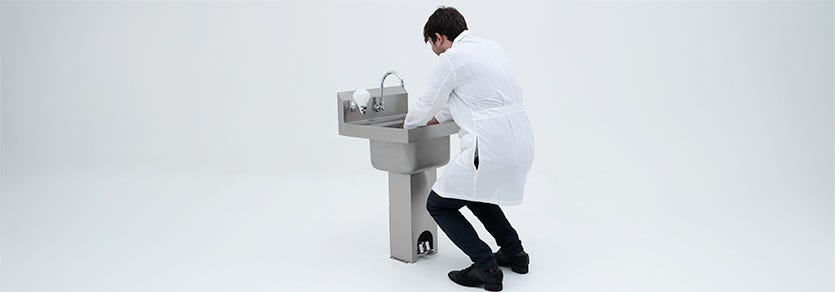- +1 (714) 578-6100
Hours Mon - Fri, 07:00 AM - 06:00 PM (Pacific Time)

Cleanroom Cleaning vs Sterilization vs Disinfection | Hygiene Standards
Posted:
July 07, 2023
This article defines and contrasts the differences between cleaning, sanitation, and disinfection. Herein, we'll examine the following topics regarding cleaning, sterilization, and disinfection in cleanrooms, hospitals, pharmacies, and other controlled environments:
- General hygiene requirements for cleanroom facilities
- Cleaning, disinfection, sterilization definitions
- Procedural differences between cleaning, sanitation, disinfection, and sterilization
- Frequently asked questions regarding cleaning practices, disinfection routines, and sterile outcomes
General Cleanroom Hygiene Standards
- All cleanrooms must maintain a specific set of procedures and operations for cleaning, sanitation, and disinfection that includes the specific order of cleaning activities, MDS sheets for all chemicals and cleaning equipment, and describe the frequency and intensity of decontamination activities
- Buildings must be maintained in a clean/sanitary condition that is free of infestation by rodents, birds, insects, and other vermin
- Trash and organic waste must be contained and disposed of in a timely and sanitary matter
- All tools, containers, and fixtures used in the cleaning process should be cleaned to the same degree as the cleanroom surfaces. All of these items are a source of contamination.
- All chemicals, wipes, and cleaning supplies must meet or exceed the ISO-specified classification levels of the area in which the activity takes place (ISO-5 rated enclosure hood requires ISO-5 rated supplies and garments)
- The drying of hands, surfaces, or equipment prohibits the use of paper or fabric towels. Hand dryers equipped with HEPA filters are suggested.
- Only garments approved for the cleanroom should be worn when entering.
- Items used in a specific area of cleanliness, such as an ISO-5 primary engineering control, should not be used in ISO 6 - ISO 8 areas
- Generally, clean from cleanest area to dirtiest area, and from top to bottom
Define Cleaners vs Sterilants vs Disinfectants
Before we get into specific types and uses of various cleaners, disinfectants, and sterilants, we must first understand essential references to different types of cleaning chemicals and cleaning practices.
Cleaning: Refers to an automated or mechanical action that should occur before sanitation and disinfection, or as a combined effort. The act of cleaning does require any measurable reduction in microbial colony counts and only refers to the removal of grit, grime, debris, or other matter from contacted surfaces.
Cleaners: The most common standard cleaning agents include soaps, shampoos, and other types of detergents.
Washing: This method involves using water and to physically remove contaminants from the surface. It is commonly used for decontaminating dishes, clothing, and other washable items.
Detergents: The main purpose of a detergent is to facilitate the removal of dirt and stains by interacting with them in a way that allows them to be easily rinsed away with water. Detergents achieve this through a combination of several properties:
Disinfection: The CDC defines disinfection as a process that eliminates many or all pathogenic microorganisms, except for bacterial spores.
Sterilization: Destroys all microorganisms, including bacterial spores.
Sterility refers to the absence of living things, including spores and related substances, that could develop into something living. Assessment of sterility is most commonly performed by culturing samples with special growth media.
Q: What Are the 4 Primary Methods of Physical and Chemical Decontamination
A: There are 4 main categories of physical and chemical means of decontamination:
- Heat
- Liquid disinfection
- Vapors and gases
- Radiation
Q: What is the Difference Between Cleaning, Sanitation, Disinfection, and Sterilization?
A: The difference between disinfectants/sterilants and soaps/detergents, is that sterilants and disinfectants are designed to provide measurable reductions in colony-forming units (CFUs) within a specified period of time. In contrast, cleaners and detergents are designed to remove matter or materials but do not require a reduction in bacterial burdens by definition.
Q: What is the Difference Between Disinfectants and Sterilants?
A: The simple difference between sterilants and disinfectants is that sterilants are designed to eradicate fungal and bacterial spores in a short period, usually within 5 - 30 minutes.
Continue: Tips for Safe Chemical Handling & Storage
Q: How Do Soaps and Detergents Work?
A: Soaps and detergents are common in healthcare facilities for pre-cleaning visible organic residues and bio-films including blood, tissue, inorganic salts, and other types of matter. Soaps and detergents work based on the following mechanisms:
Surfactant action: Detergents contain surfactants, which are molecules that lower the surface tension between liquids. This helps the detergent to spread across the surface being cleaned, enabling it to penetrate and lift away dirt particles.
Emulsification: Detergents can emulsify oily or greasy substances, thus surrounding oil or grease particles, and allowing them to mix with water and be rinsed away.
Dispersing and suspending properties: Detergents can disperse and suspend dirt particles in water, preventing them from redepositing onto surfaces. This ensures that dirt is effectively removed during rinsing.
Solubility: Detergents are designed to dissolve in water, making it easier for them to interact with and remove different types of dirt and stains.
Need Assistance with Your Facilities Decontamination Programs?
Terra Universal offers a wide selection of in-stock cleanroom cleaning products including total environments, waste receptacles, glove/garment dispensers, garment hampers, gowning furniture, and more. Many products are stocked and ready to ship in just 1 - 3 days from Terra's California facilities.
Contact a Terra specialist via phone, email, or start a live chat with a Terra specialist.
Terra Universal is the leading expert in the design and fabrication of ISO rated cleanrooms, furnishing and supplies.
Get a free consultation from one of our cleanroom specialists:
Call (714) 459-0731


